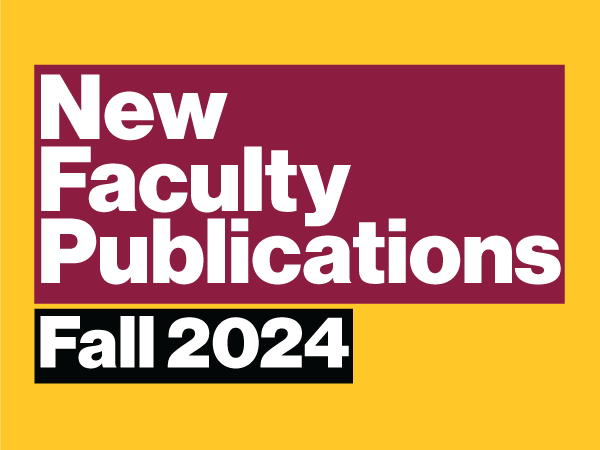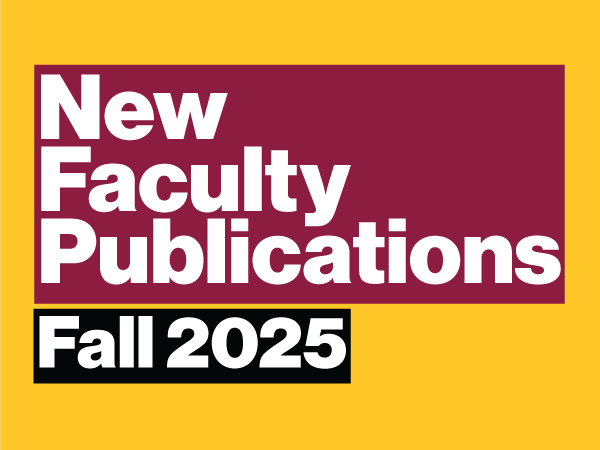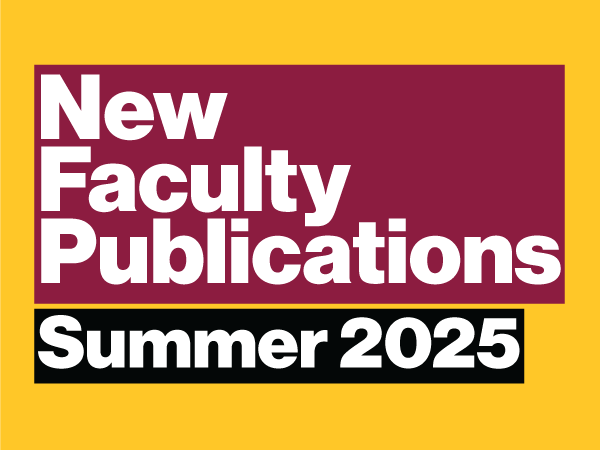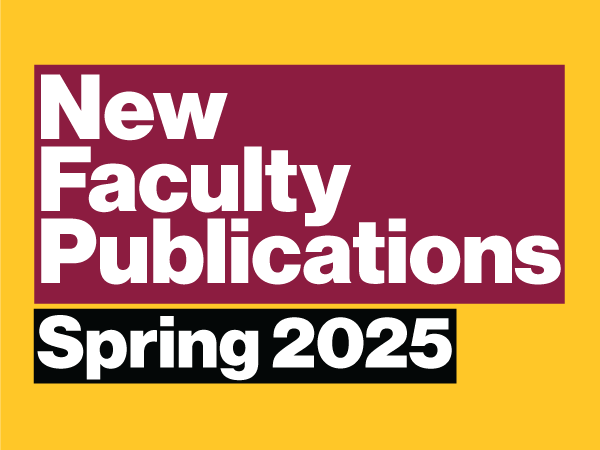This bibliography comprises scholarly books, book chapters, and journal articles published or accepted for publication by full-time, emeritus, and retired faculty of the Sandra Day O’Connor College of Law between July 1, 2024 and September 30, 2024.
Dan Bodansky, Four Treaties in One: The Biodiversity Beyond National Jurisdiction Agreement, 118 American Journal of International Law 299 (2024)
Combine and conquer. That was the strategy of those seeking to develop an international regime to address marine biological diversity found in areas beyond national jurisdiction—areas that constitute half of the world’s surface and a much greater proportion of its habitable volume. States had quite different visions for the regime. On the one hand, the European Union and other developed countries such as Australia and New Zealand wanted a conservation-oriented regime providing for the establishment of marine protected areas and setting rules for environmental impact assessments; on the other hand, developing countries wanted a resource-oriented regime that would allow them to get what they consider their fair share of the benefits of marine genetic resources and would assist them with capacity building and technology transfer. Only by combining these disparate topics in a single package was agreement possible.
Charles F. Capps, Does the Law Ever Run Out?, 100 Notre Dame Law Review (forthcoming 2025)
Although laypeople commonly believe that the job of a judge is to decide every case as the law requires, a broad consensus exists among legal scholars that the law not infrequently “runs out,” leaving the judge with no choice but to settle the parties’ dispute on extralegal grounds. That consensus is difficult to square with the plausible claim that deciding even close cases by coin toss is not only morally but legally objectionable. If following all the procedures prescribed by law for deciding a case fails to lead the judge to an outcome, then it is hard to see why the judge violates her legal duties if she settles the dispute by flipping a coin.
This Article offers a tentative defense of the popular idea that the judge’s job in every case is to follow the law to an outcome. The Article examines the features of the law that allegedly cause it to run out, including permissive rules, balancing tests, vagueness, ambiguity, silence, contradictions, and uncertainty. Tentatively, the Article concludes that none of these features causes the law to run out. More confidently, it maintains that the extent, if any, to which the law runs out depends on difficult issues in the philosophy of law, language, and value—issues that parties to the consensus that the law runs out in a significant range of cases do not appear to have worked through to resolution.
When, if ever, the law runs out has several important implications: for judicial ethics, for the proper scope of Auer deference and other legal doctrines, and for adjacent scholarly debates such as the debate over the interpretation-construction distinction.
Susan Chesler & Elizabeth Porter, Contracting for the Company’s Culture, Arizona State University Sandra Day O’Connor College of Law Paper No. 4928148 (August 30, 2024)
Company culture is not a new phenomenon. A company’s culture has always been relevant to employee retention and financial success, but recently its importance cannot be understated. Companies are not immune from the culture wars that divide the United States and countries across the globe. Increasingly, companies have become participants-willingly or not-in a wide range of social and political controversies. A company’s stakeholders in these ongoing culture wars include their employees, investors, and consumers. And those stakeholders make choices about which companies they want to work for, invest in, purchase from, and even boycott, based in part on a company’s beliefs and behaviors surrounding a variety of social issues like gender equality, diversity, and sustainability. These stakeholders are growing more critical of companies’ performative attempts to pacify them and often characterize such attempts as greenwashing or blackwashing. They expect companies to embrace these issues and incorporate their values into the way the company operates, both internally and externally. While contract drafting is rarely seen as an avenue for developing and communicating company culture, let alone as a vehicle for social change, in this article we propose that contract drafting can be used to achieve both goals. By incorporating narrative techniques and impactful language, companies can use their contracts to tell the stories of the company culture that has become so important to their success, which can in turn lead to broader social change.
Adam Chodorow, Saban, Pope, and the Benefits Theory of Taxation, Arizona State University Sandra Day O’Connor College of Law Paper No. 4932869 (September 20, 2024)
As a condition for receiving federal highway funding, Congress requires states to spend the revenues they raise from road users on the roads. Congress justified this condition, in part, because wanted federal money to supplement—not replace—state money and, in part, on fairness grounds, essentially endorsing the benefits theory of taxation, under which taxes can be justified based on the benefits taxpayers receive. To safeguard these federal funds and prevent legislatures from using road use revenues for other purposes, most states added anti-diversion provisions to their constitutions. A majority specifically identified the taxes their anti-diversion provisions would cover. However, a few—including Ohio and Arizona—adopted broad language providing that revenues from “fees, excises, or license taxes relating to registration, operation, or use of vehicles on the public highways or streets” be spent on the roads.
Despite the broad language found in Arizona’s provision, Arizona’s Supreme Court—relying in part on Ohio’s jurisprudence—narrowly construed the state’s anti-diversion provision to apply only to a narrow class of taxes. This article considers Arizona’s jurisprudence—and in particular cases considering the rental car taxes used to fund Cardinal stadium and a rental car facility at Phoenix’s Sky Harbor airport—to show how the courts have gone astray, drifting further and further away from the provision’s underlying purpose, shortchanging drivers whose money is being spent for non-road purposes, and potentially putting Arizona’s federal highway dollars at risk.
Laura Coordes, Bankruptcy and the Public-Private Divide, Arizona State University Sandra Day O’Connor College of Law Paper No. 4920184 (September 11, 2024)
The Bankruptcy Code draws a firm line between “municipalities” and other entities. In reality, numerous entities exist that could be categorized as falling somewhere between a purely public municipality and a private entity. This incongruence between theory and practice creates two primary sets of problems. First, when a “blended entity” seeks to file for bankruptcy, the relief it receives from the bankruptcy system, if any, may be practically inappropriate or constitutionally suspect. Second, blended entities’ use of the bankruptcy system creates uncertainty, which parties and courts can capitalize on to manipulate the system. The result is incoherent bankruptcy law, which in turn spurs more uncertainty. This cycle of uncertainty, manipulation, and incoherence parallels that which is occurring in larger bankruptcy cases involving business debtors. This Article is the first to take an in-depth look at blended entities and the problems that ensue when they attempt to use a bankruptcy system that does not contemplate their existence. In doing so, it contributes to the larger debate about the usefulness of the current Bankruptcy Code in light of manipulation of the bankruptcy laws and exposes a core weakness in the Code’s inability to recognize the blended nature of many of the entities that form the backbone of the U.S. economy, providing the services the public has come to rely on in everyday life.
Laura Coordes, The Anti-Modification Rules’ Application to Mixed Property: “It depends on what the meaning of the word ‘is’ is”, 44 Bankruptcy Law Letter 1 (September 2024)
Last May, in Lee v. U.S. Bank, the Eleventh Circuit split with the First and Third Circuits on the question of when real property is subject to the Bankruptcy Code’s anti-modification rules. Circuit splits sometimes receive a great deal of attention; this particular split, however, did not seem to generate quite so much commentary, at least initially. This may be due to the highly technical nature of courts’ analysis of the anti-modification provisions; after all, much of the majority and dissent’s disagreement in the Eleventh Circuit rested on conflicting interpretations of the word “is.” Or, it may be due to the fact that the Eleventh Circuit’s decision was the first at the circuit-level to address this anti-modification question in some time; the First and Third Circuits’ decisions date back 28 and 18 years, respectively.
Despite the relative lack of commentary on the Eleventh Circuit’s decision, this Bankruptcy Law Letter posits that the decision, and the potential trend it represents, raise issues worth exploring. I will begin by walking through the state of the anti-modification analysis prior to Lee, examining the statutory anti-modification rules, their legislative history, and the case law interpreting them. I’ll then examine and critique the Eleventh Circuit’s ruling in Lee and provide some thoughts about where anti-modification analysis ought to go from here. The issues surrounding the Code’s anti-modification provisions speak to the desirability of chapter 11 and chapter 13 bankruptcy for debtors, and their resolution will impact the Code’s ultimate balance between debtors and creditors.
Laura Coordes, Exploring the Reach of Redwater, 43 American Bankruptcy Institute Journal 22 (2024)
In 2019, the treatment of environmental remediation costs in Canadian insolvency proceedings shifted significantly when the Supreme Court of Canada (SCC) decided Orphan Well Ass’n v. Grant Thornton Ltd. (Redwater). The SCC’s Redwater decision gave significant support to the “polluter pays” principle, holding, in essence, that environmental clean-up orders were duties owed to the public that must be fulfilled, rather than unsecured claims that could be given low priority in a bankruptcy. Redwater is so significant that it has been covered twice before in this publication.
More than five years have passed since the SCC decided Redwater, and courts, practitioners and parties to insolvency proceedings in Canada have been both adapting to the decision’s impacts and testing its reach. This article explores two recent cases interpreting this decision, showing that Canadian case law still has many issues to tackle when it comes to Redwater’s reach.
Sandra Erickson et al., Navigating Your Legal Master’s Program: A Roadmap for Success (West Academic 2024)
The legal master’s is one of the nation’s fastest-growing degree programs, and Navigating Your Legal Master’s Program: A Roadmap for Success is the first comprehensive preparation guide to help students succeed in their chosen program – whether on-ground or online – and beyond. Written by four legal master’s degree administrators with over forty years of collective experience directing and teaching in legal master’s programs offered from prestigious law schools, this book answers the following questions for students:
1. What is a legal master’s degree and why is it beneficial?
2. What should I know about the law before entering the program?
3. What can I expect to experience in a law school classroom and how can I best prepare for it?
4. Whether I am part-time, full-time, online, or on campus, how can I connect with the law school community and what are the benefits of doing so?
In addition to delivering guidance from the authors and program administrators, the book offers valuable insights from twenty legal master’s alumni, providing a roadmap for success from those who have succeeded. Navigating Your Legal Master’s Program: A Roadmap for Success will prepare you to experience profound personal growth and act as a driving force for your professional success through your legal master’s program.
James G. Hodge, Jr. & Jennifer L. Piatt, Emergency Legal Preparedness & Response: U.S. Supreme Court Impacts, Arizona State University Sandra Day O’Connor College of Law Paper No. 4908863 (August 23, 2024)
U.S. Supreme Court (SCOTUS) opinions from the inception of the COVID-19 pandemic to date are reshaping national and regional abilities to respond to public health emergencies (PHEs). Substantial impacts in emergency legal preparedness and response include the Court’s: (1) recalibrating federal executive and administrative agency emergency authorities; (2) altering base-level rights and access to emergency care; (3) elevating First Amendment religious principles visa -vis social distancing; (4) restricting vaccination and other public health interventions; (5) asserting race-based limitations applicable in public health resource allocations; (6) addressing misinformation; (7) approaching gun violence as a public health threat; and (8) clarifying the scope of liability during and after emergencies. Against this backdrop an array of legal options and critical take-aways may help mitigate SCOTUS’ impacts to advance effective emergency responses ahead.
Rhett Larson, Quantifying Winters Rights, 48 William & Mary Environmental Law and Policy Review 659 (2024)
All reservations of federal land, including Native American reservations and national forests, have water rights. These rights are referred to as “Winters rights” after the seminal U.S. Supreme Court case. That case recognized such rights’ existence, but it did not quantify the amount of water of those rights. Federal courts have applied various approaches to quantifying Winters rights. Recent decisions in Arizona state courts have taken new and different approaches to quantification of both tribal and non-tribal Winters rights. These state court decisions have important implications for federal water rights throughout the United States. This Article examines these new approaches to quantifying Winters rights, evaluates them for their impact on equitable and sustainable water policy, and proposes reforms to better adapt the adjudication of Winters rights to responding to water variability caused by climate change.
Stacy Leeds & Angelique Wambdi EagleWoman, Mastering Native American Law (3rd ed., Carolina Academic Press 2024)
Mastering Native American Law is designed to provide readers with an overview of the field and serve as a useful supplement to classroom instruction covering Tribal nations governance and law, federal Indian law, and Tribal Nation-state government relations. In ten chapters, the book provides the reader with a foundational understanding of core concepts stemming from American Indian and Alaska Native Tribal Nations.
This third edition keeps pace with Tribal Nation legal developments in relation to policy, federal law, and court decisions, while it continues to fill a unique niche as a primary and secondary text for courses in the field. Updates are provided for key developments such as the recent U.S. Supreme Court decisions on the extent of criminal prosecutorial authority in Indian Country and the federal legislative authority for the Indian Child Welfare Act. The text also serves as a practical guide for Tribal law practitioners and lawyers that are looking to expand their knowledge of Native American law.
Gary E. Marchant & Diana Bowman et al., Learning From Emerging Technology Governance for Guiding Quantum Technology, Arizona State University Sandra Day O’Connor College of Law Paper No. 4923230 (September 13, 2024)
Quantum technology is often described as the “next big thing.” But the past few decades have brought us a series of next big things in technology, and we have accumulated enough experience now to start to extract some lessons and recommendations from our recent history of technology governance. That is what this article seeks to do. It first explains what quantum governance is and why people expect it to be such a big deal. The article then describes the existing. Limited regulations in place for quantum technologies, and then discusses some of the key governance challenges that quantum is expected to present. It then provides three case studies of other recent “next big thing” emerging technologies – biotechnology, nanotechnology and artificial intelligence. While each technology presents unique governance issues and challenges, the case studies extract a total of 15 lessons that may be relevant for quantum governance. The article next examines seven types of governance frameworks that have been proposed of emerging technologies by leading international and national organizations, with each type of framework providing a different emphasis, that focus on governance that is anticipatory, agile/adaptive, equitable, sustainable, soft law, coordinated and international. Finally, drawing from three technology case studies and the seven types of governance frameworks, the article identifies and discusses eight governance pillars that are common to each emerging technology and which collectively provide the foundation for effective governance, and project how these eight pillars will apply to quantum technology. These analyses provide a comprehensive roadmap, lessons and recommendations for the coming challenges of quantum technology governance.
Gary E. Marchant et al., Governing New Technologies that Stop Biological Time: Preparing for Prolonged Biopreservation of Human Organs in Transplantation, American Journal of Transplantation (forthcoming 2024)
Time limits on organ viability from retrieval to implantation shape the US system for human organ transplantation. Preclinical research has demonstrated that emerging biopreservation technologies can prolong organ viability, perhaps indefinitely. These technologies could transform transplantation into a scheduled procedure without geographic or time constraints, permitting organ assessment and potential preconditioning of the recipients. However, the safety and efficacy of advanced biopreservation with prolonged storage of vascularized organs followed by reanimation will require new regulatory oversight, as clinicians and transplant centers are not trained in the engineering techniques involved or equipped to assess the manipulated organs. Although the Food and Drug Administration is best situated to provide that process oversight, the agency has until now declined to oversee organ quality and has excluded vascularized organs from the oversight framework of HCT/Ps. Integration of advanced biopreservation technologies will require new facilities for organ preservation, storage, and reanimation plus ethical guidance on immediate organ use versus preservation, national allocation, and governance of centralized organ banks. Realization of the long-term benefit of advanced biopreservation requires anticipation of the necessary legal and ethical oversight tools and that process should begin now.
Antonia Miceli, Teaching Dobbs as a Contemporary Case Study of Federalism in Action and an Introduction to the Cross-Disciplinary Nature of the Law, 17 Saint Louis University Journal of Health Law & Policy 285 (2024)
With its decision in Dobbs v. Jackson Women’s Health Organization, the U.S. Supreme Court ended the constitutional right to an abortion, overturning Roe v. Wade and Planned Parenthood v. Casey, and returned the issue of legal access to an abortion to the states. Prior to Dobbs, reproductive rights and the right to an abortion were firmly situated within the substantive due process and fundamental rights coverage of law school constitutional law courses. But this coverage often falls late in, or completely outside the scope of, the required constitutional law curriculum at U.S. law schools. This Article offers the Dobbs decision as an opportunity for constitutional law professors to begin their coverage of the right to an abortion earlier in the required constitutional law curriculum in a manner that moves away from a strictly “Case-Method” study of law to a more accessible cross-disciplinary study of law.
By using Dobbs as a contemporary case study of federalism in action, constitutional law professors can utilize a rich variety of readily available resources to make the legally complex concept of federalism more approachable and accessible to a wider assortment of students, including students with learning disabilities. Professors also can use Dobbs as an introduction to the cross-disciplinary nature of the law by exploring Dobbs’ impact on other academic disciplines including medicine, business and economics, and political science, while empowering students to engage with their law school studies in a more meaningful and active manner. This Article presents exercises for both recommended uses of Dobbs, which apply different teaching modalities inside and outside the classroom, allowing constitutional law professors to support their students in developing new critical thinking skills that support a greater understanding of the law and the intersections between the legal profession and other areas of academic pursuit.
Roselle Wissler & Art Hinshaw, Comparing Joint Session and Caucus Outcomes: Factoring in Substantive Discussions and Case Characteristics, 25 Cardozo Journal of Conflict Resolution 491 (2024)
Many of the traditional components of initial joint sessions occur less frequently today than they did historically and are more likely to take place during initial caucuses than during initial joint sessions. These changes in mediation practice lead to questions about whether initial joint sessions still provide the benefits historically attributed to them and whether initial caucuses now provide not only the benefits specifically ascribed to them but also the benefits typically associated with initial joint sessions. The present Article addresses these questions while taking into consideration differences in case and mediator characteristics as well as the extent of discussions in each setting. The findings are based on the survey responses of over 1,000 mediators in general civil and family cases across eight states.
There were differences between cases that began mediation in joint session versus in caucus in several intermediate outcomes associated with the initial session, especially in civil cases, but few differences in final outcomes between cases where the disputants spent some versus no time together during the entire mediation. However, for the most part the differences disappeared or were reduced after we statistically adjusted for the extent of substantive discussions among the mediator, the disputants, and the lawyers as well as several case and mediator characteristics. Thus, the outcome differences largely appear to be explained by differences in the extent of discussions that occur during the initial mediation session as well as differences in case characteristics rather than simply by whether the disputants are together or apart during the mediation. The findings do not support some common assertions about the relative benefits of initial joint sessions and initial caucuses or the benefits of the parties being together for some time during the mediation, but they do provide evidence for the informational and relational benefits of mediation more generally.
Glenn M. Wong et al., General Counsels in Sports: An Updated and Expanded Analysis of the Responsibilities, Demographics, and Qualifications, 13 Arizona State Sports & Entertainment Law Journal 1 (2024)
This Article builds upon the prior findings of our 2017 article, General Counsels in Sports: An Analysis of the Responsibilities, Demographics, and Qualifications. That Article provided an in-depth analysis of the responsibilities, demographics, and qualifications for General Counsels of the clubs in the National Football League (NFL), Major League Baseball (MLB), the National Basketball Association (NBA), and the National Hockey League (NHL). This Article updates that work, examines the role of General Counsel within a Major League Soccer (MLS) club, and compares the backgrounds of the present MLS General Counsels to the General Counsels of the other leagues. Additionally, this Article discusses the Women’s National Basketball Association (WNBA) and the National Women’s Soccer League (NWSL); however, currently, the majority of clubs within these two leagues do not have enough internal legal counsel to provide comprehensive data for a complete analysis.
As to the NFL, MLB, NBA, and NHL, we found the following changes: (1) an increase in the number of Black/African American General Counsels, but only a very slight increase for other racial/ethnic groups; (2) an increase in gender diversity, with significantly more women General Counsels today; (3) an increase in General Counsels with prior legal experience in the sports industry; (4) an increase in General Counsels with prior experience at prominent sports law firms, most of whom assume roles within the NFL; and (5) an increase in the number of General Counsels with prior experience in an Associate Counsel role.
Additionally, when examining the MLS General Counsels in comparison to their counterparts in the other leagues, we found that MLS General Counsels are generally: (1) younger and have fewer years of prior legal experience before assuming the role; (2) of greater racial/ethnic diversity, specifically Asian/Asian American and Hispanic heritage; (3) include notably more women; (4) more likely to come from law schools and law firms of lower prestige and ranking; and (5) more likely to have prior experience working at a league office or in a prior role as an Associate Counsel.
Lastly, this Article discusses possible changes to the role of General Counsel as it adapts to broader developments in the sports industry, emerging technologies, and the changes across the legal field. In total, this Article provides an updated and expanded comprehensive understanding of the role of General Counsel.




